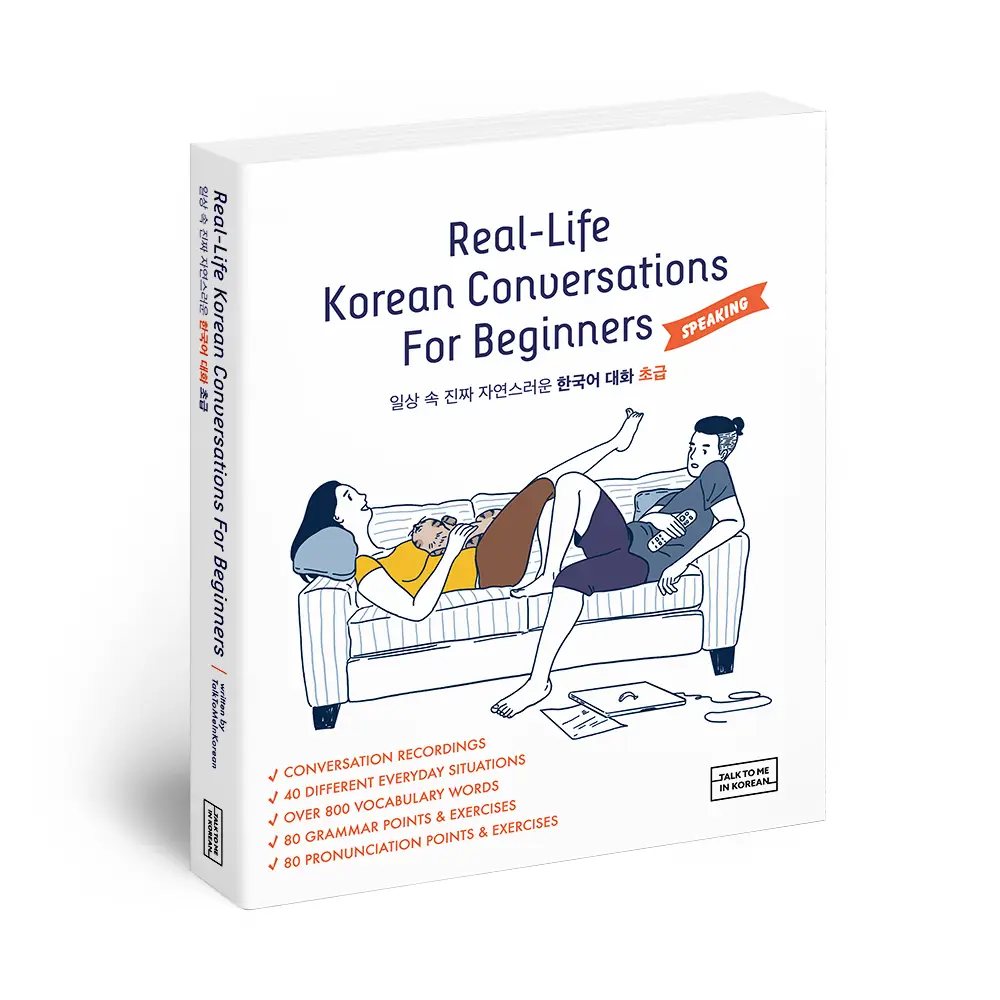Starting out on the path to learning Korean can feel exciting yet overwhelming, especially for beginners. But fear not! One of the keys to success is picking the right tools for the job. With so many options out there, it's essential to find books that fit your learning style and level.
In this blog post, we're going to dive into some of the best books for beginners in Korean. From everyday conversations to grammar basics and even learning through K-pop, we've got you covered with the best recommendations to kickstart your Korean learning adventure. So, let's find the perfect book for you!

1. Real-Life Korean Conversation for Beginners

Real-Life Korean Conversation for Beginners offers a practical and immersive approach to mastering conversational Korean. Unlike traditional textbooks that may focus heavily on grammar rules and vocabulary lists, this book prioritizes real-life scenarios and everyday interactions. By simulating authentic conversations that learners are likely to encounter in various social settings, such as greetings, shopping, dining out, and making plans, it provides a more engaging and effective learning experience.
The book is structured around a series of dialogues, each accompanied by helpful explanations of key phrases and expressions. Learners can listen to the dialogues through audio recordings, which aid in improving pronunciation and listening comprehension skills. Additionally, the inclusion of exercises and activities reinforces learning and encourages the practical application of newly acquired language skills.
One of the main advantages of Real-Life Korean Conversation for Beginners is its emphasis on context and cultural nuances. Through the dialogues, learners not only learn the language but also gain insight into Korean culture and social norms. This holistic approach enhances cultural understanding and enables learners to communicate more confidently in real-world situations.
However, like any resource, this book also has its drawbacks. Some learners may find the pace of progression too fast or the level of difficulty inconsistent throughout the book. Additionally, while the dialogues cover a wide range of topics, they may not fully address every possible scenario a learner could encounter. Despite these limitations, Real-Life Korean Conversation for Beginners remains a valuable resource for beginner learners looking to develop practical speaking skills in Korean.
Pros and Cons
Pros:
- Emphasis on real-life scenarios and everyday interactions
- Structured dialogues with explanations and audio recordings
- Exercises and activities for reinforcement
- Provides cultural insights and context
Cons:
- Pace of progression may be too fast for some learners
- Inconsistent difficulty level throughout the book
- Not exhaustive in covering all possible conversational scenarios
2. Korean Stories for Language Learners

Korean Stories for Language Learners presents a captivating approach to language acquisition through storytelling—a method that has proven to be highly effective in language learning. Stories engage learners on multiple levels, immersing them in the language while also providing cultural insights and context. By weaving language into narratives, learners are not only exposed to new vocabulary and grammar structures but also gain a deeper understanding of Korean culture and customs.
The selected Korean storybooks for beginners featured in this resource are carefully curated to cater to learners at various proficiency levels. These storybooks often incorporate simplified language and include helpful features such as glossaries, comprehension questions, and audio recordings to aid in understanding and pronunciation. From traditional folktales to modern short stories, the diversity of content ensures that learners can explore different genres while expanding their language skills.
One of the primary benefits of using stories as a language-learning tool is their ability to facilitate vocabulary acquisition in context. Instead of memorizing isolated words, learners encounter new vocabulary within the natural flow of a narrative, making it easier to grasp and retain. Additionally, stories provide a rich context for cultural exploration, exposing learners to cultural practices, values, and perspectives embedded within the language.
Furthermore, the immersive nature of storytelling fosters a sense of engagement and motivation among learners, making the language-learning process more enjoyable and rewarding. By delving into Korean stories, learners not only enhance their language proficiency but also develop a deeper appreciation for Korean literature and culture.
In summary, Korean Stories for Language Learners offers an enriching and enjoyable approach to language acquisition, leveraging the power of storytelling to enhance vocabulary acquisition, cultural understanding, and overall language proficiency. Whether you're a beginner or an advanced learner, exploring Korean stories is sure to elevate your language-learning journey to new heights.
Pros and Cons
Pros
- An engaging approach to language learning through storytelling
- Carefully curated selection of storybooks for beginners
- Facilitates vocabulary acquisition in context
- Provides cultural insights and understanding
Cons
- Limited availability of storybooks tailored specifically for beginner learners
- May require supplemental materials for comprehensive language learning

3. Korean Grammar in Use

Korean Grammar in Use is a valuable resource for learners aiming to achieve fluency in the Korean language. Grammar forms the backbone of language proficiency, and mastering Korean grammar is essential for effective communication and comprehension. This book provides a comprehensive overview of Korean grammar, offering learners a structured approach to understanding and applying grammatical concepts.
The book is organized into clear and concise chapters, each focusing on a specific grammar point or concept. Beginning with foundational topics and gradually progressing to more advanced structures, the book caters to learners at different stages of proficiency. Each chapter includes explanations of grammar rules, accompanied by numerous examples and practice exercises to reinforce learning.
From basic sentence structure to complex verb conjugations and sentence endings, Korean Grammar in Use covers a wide range of grammar concepts essential for language mastery. Learners will encounter topics such as honorifics, sentence particles, verb tenses, and conjunctions, among others. By providing ample examples and explanations, the book helps learners grasp the nuances of Korean grammar and apply them effectively in both written and spoken contexts.
To maximize the effectiveness of this resource, learners can utilize various strategies for effective usage. Regular practice, review, and application of grammar concepts in everyday communication are essential for retention and proficiency. Additionally, seeking clarification from teachers or language exchange partners can help clarify any doubts or difficulties encountered while studying.
Despite its many strengths, Korean Grammar in Use may have some drawbacks. Some learners may find certain grammar explanations challenging to understand, especially without sufficient background knowledge of Korean language structure. Additionally, the book's focus on grammar may not suit every learner's preferred learning style, as some individuals may prefer a more communicative or immersive approach.
Pros and Cons
Pros
- Comprehensive coverage of Korean grammar concepts
- The structured organization facilitates learning progression
- Ample examples and practice exercises for reinforcement
- Clear explanations aid in understanding complex grammar rules
Cons
- Some grammar explanations may be difficult to grasp without prior knowledge
- Focus on grammar may not appeal to all learning preferences
4. Learn Korean with BTS

Learn Korean with BTS offers a unique and innovative approach to language learning by harnessing the popularity and cultural influence of the Korean boy band BTS. With millions of fans worldwide, BTS has become a global phenomenon, making them an ideal vehicle for introducing learners to the Korean language and culture.
This book seamlessly integrates BTS content, including song lyrics, interviews, and behind-the-scenes footage, into language learning materials. Learners are exposed to authentic Korean language usage in various contexts, allowing them to practice listening, speaking, reading, and writing skills while immersing themselves in BTS's music and culture.
Using pop culture as a learning tool provides numerous benefits for language learners. Not only does it make the learning process more enjoyable and engaging, but it also fosters a deeper connection to the language and culture. Learners can relate to the content on a personal level, motivating them to actively engage with the material and persist in their language learning journey.
Additionally, Learn Korean with BTS offers learners the opportunity to learn from real-life examples and experiences shared by BTS members themselves. Through interviews, anecdotes, and personal reflections, learners gain insights into the linguistic and cultural nuances of the Korean language, as well as valuable tips and strategies for language learning success.
Pros and Cons
Pros
- Utilizes engaging and relevant content from BTS to facilitate language learning
- Integrates various language skills, including listening, speaking, reading, and writing
- Provides cultural insights and behind-the-scenes glimpses into Korean pop culture
- Appeals to fans of BTS and K-pop, making language learning more enjoyable and relatable
Cons
- Focus on BTS content may limit appeal to learners who are not fans of the group or K-pop
- May not cover all aspects of language learning comprehensively, requiring supplemental materials for a well-rounded education

5. Korean Made Simple

Korean Made Simple offers a comprehensive and structured approach to learning Korean, designed to make the language accessible and enjoyable for beginners. Authored by Billy Go, a passionate language educator, this book provides clear explanations, practical examples, and interactive exercises to help learners build a solid foundation in Korean language and culture.
The book is divided into logical sections, starting with basic grammar and gradually progressing to more advanced topics. Each chapter focuses on a specific grammar concept or vocabulary theme, providing ample opportunities for practice and reinforcement. With a focus on practical usage and real-life examples, Korean Made Simple equips learners with the skills they need to communicate effectively in Korean.
One of the key benefits of Korean Made Simple is its user-friendly approach, making complex grammar concepts easy to understand. Practical vocabulary lists and cultural insights enhance learning and provide valuable context for language usage. Interactive exercises and quizzes keep learners engaged and track their progress, while audio recordings of native speakers aid in pronunciation and listening comprehension.
To make the most of Korean Made Simple, learners are encouraged to set aside dedicated study time each day and practice speaking and listening to Korean regularly. Reviewing previous chapters periodically helps reinforce learning and ensure retention of material. By following these tips and engaging with the material actively, learners can maximize their language learning potential and progress confidently on their Korean language journey.
Pros and Cons
Pros
- Structured approach to learning Korean makes it suitable for beginners.
- Clear explanations and examples facilitate understanding of grammar concepts.
- Interactive exercises and quizzes provide opportunities for active learning.
- Audio recordings of native speakers aid in pronunciation and listening comprehension.
Cons
- May not cover all aspects of Korean language and culture comprehensively.
- Focus primarily on grammar and vocabulary may not suit all learning preferences.
- Additional supplementary materials may be needed for a more well-rounded language learning experience.
Final Words
In conclusion, we've explored a range of resources tailored to beginner learners embarking on their journey to master the Korean language. From Real-Life Korean Conversation for Beginners, which prioritizes practical communication skills, to Korean Stories for Language Learners, which immerses learners in cultural narratives, and Korean Grammar in Use, which provides a structured approach to mastering grammar, each book offers unique benefits for language acquisition. Additionally, Learn Korean with BTS harnesses the popularity of K-pop to engage learners in a fun and relatable way.
As you progress in your Korean language journey, remember that no single resource can provide all the tools you need for comprehensive learning. Combining multiple resources, such as textbooks, online courses, language exchange programs, and immersion experiences, can enhance your understanding and proficiency in Korean. Each resource offers different perspectives and approaches to language learning, allowing you to tailor your study methods to suit your individual learning style and goals.
To all beginner learners out there, I encourage you to dive into your Korean language journey with enthusiasm and determination. Learning a new language is a rewarding and transformative experience that opens doors to new cultures, connections, and opportunities. Embrace the challenges, celebrate your progress, and never hesitate to seek support and guidance along the way. With dedication and perseverance, you'll soon find yourself confidently navigating the vibrant world of the Korean language. Good luck!
Learn Korean With Lingopie Through K-Dramas!
Lingopie is like your language learning buddy, but cooler. You get to watch awesome Korean TV shows and movies, soak up real-life conversations, and catch the vibe of the culture. And the best part? You can click on any word or phrase in the subtitles to learn its meaning and pronunciation, making vocab and grammar a breeze.
Plus, there are fun tools like flashcards and quizzes to keep you on your toes, and Lingopie even adjusts to your learning style and goals. Oh, and you can use it offline too, perfect for when you're on the move. It's not just an app—it's a whole community of language learners cheering each other on. Lingopie makes learning Korean (or any language) fun, easy, and totally doable.
Download Lingopie from the App Store or Play Store now and get a FREE 7-day trial!







![11+ Best Shows On Netflix To Learn Korean [2025]](/blog/content/images/size/w300/2025/05/Best-Shows-On-Netflix-To-Learn-Korean.jpg)

